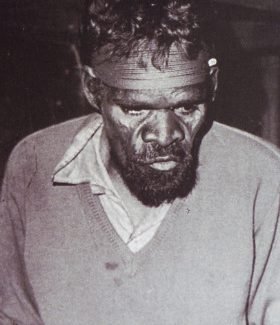ANATJARI NO. I TJAKAMARRA
MARKET ANALYSIS

Until 2010, the majority of Anatjari's top ten results were for works created during the 1990s. In this regard he stood apart from the majority of the early painters who worked with Bardon. His late career success saw two works, both created at the end of his life, overshadow the results for those he created during the early 1970s. When offered for sale through Sotheby’s in July 2003 (Lot 178) and July 2004 (Lot 108) these two paintings (created for Papunya Tula in 1989, and 1990) carried presale estimates of $100,000-150,000. Both sold for $118,000 including the buyer’s premium despite their appreciable difference in size.
In 2010 however, the resale of a 1973 board entitled Story of a Woman's Camp and the Origin Of Damper more than doubled Sotheby’s low estimate when it sold for $384,000, at its July sale (Lot 55).
This sale is in keeping with the trend that 1972-1973 boards generally fair better than those created in 1971, the first year of the Papunya movement. The fact that eight of Anatjiari’s current top ten results were created during these two years clearly indicates that collectors prefer the more accomplished imagery and greater size of these paintings to his earliest 1971 works, despite their historical significance and sacred content.
This is amply illustrated by the fortunes of two embelatic 1973 works both coincidentally entitled Kuningka. Kuningka 1973 originally sold for $74,000 at Sotheby's in 1998 when estimated at $50,000-80,000. It has been re-offered since that time. It failed to sell at Bonhams in 2011, although the ambitious estimate of $200,000-300,000 was undoubtably the cause. And failed once more in Sotheby's London Sale in 2015 when carrying a presale estimate of GBP75,000-100,000. Another work with the same name has experienced an even more tortuous journey through auction. Originally offered under the name Porcupine Danger Men Only 1973, it first appeared for sale at Sotheby's in 2001 and changed hands for $35,750. The work subsequently failed to sell at Sotheby's in 2006, Bonhams in 2011 and Deutscher & Hackett in 2014, while carrying $50,000-70,000 expectation on each occasion. Finally, in December 2019, the work was ncluded in the 33 work offering at Sotheby;s first New York venture into Aboriginal art. This time, in spite of the huge fanfair attendent to the sale and the tiny number of works on offer, it finally sold for a modest $USD47,500, or $AUD68,823 incl BP.
Anatjari's most successful year at auction was 2010. In that year all five works on offer sold at an average of $110,380 and a total of $551,900. This gave Anatjari III the highest ranking during the year of any Aboriginal artist. It propelled him to an overall rank of 15th most successful artist of the entire movement. Yet his results have not been as good since. He was 19th most successful artist in 2012 results but has had only five sales since. In 2015 a very nice rendition of a Men's Ceremony created in 1971 sold for $60,000 including buyer's premium. 2016 saw only one of the three works on offer selling, though it reached number 5 in his top ten at $93,000. Aside from breaking the top 5, Big Pintupi Ceremonial Occasion also replaced A Cave Dreaming 1972 (sold in 1996) as the highest price to date for a work created in 1972.
Anatjari III died in 1992, just before a number of his male contemporaries made the conceptual leap away from dense ethnographic iconography. The primary market prices achieved for these paintings created from the mid 1990s onward became the principle driver of the growing Aboriginal art market prior to the emergence of women’s painting in the early years of the new millennium. Even so, the paintings he created in the late 1980s are the most sought after and valued of all 1980s canvases created by men of the Western Desert. They are rare, but it is unlikely that sales of his late career works will dominate those of his very best early (1972-1973) boards. For this reason he is likely to be considered as an important early influence in the emergence of desert painting rather than an artist of supreme distinction.
